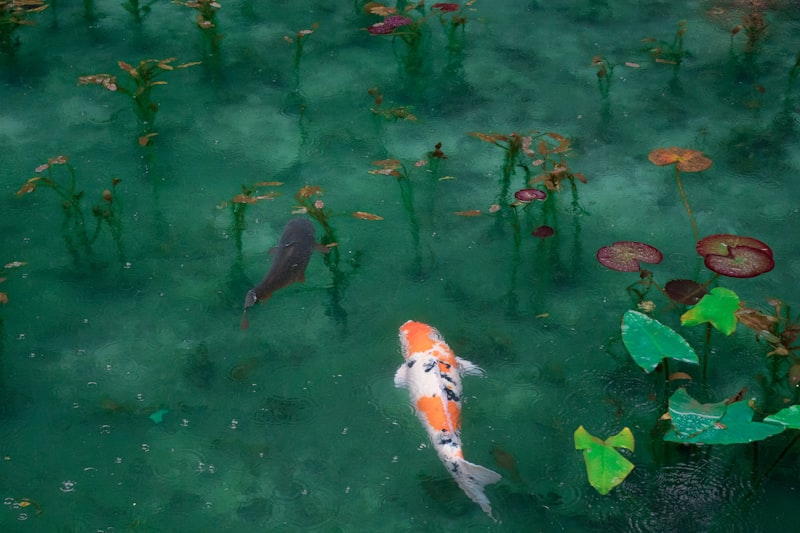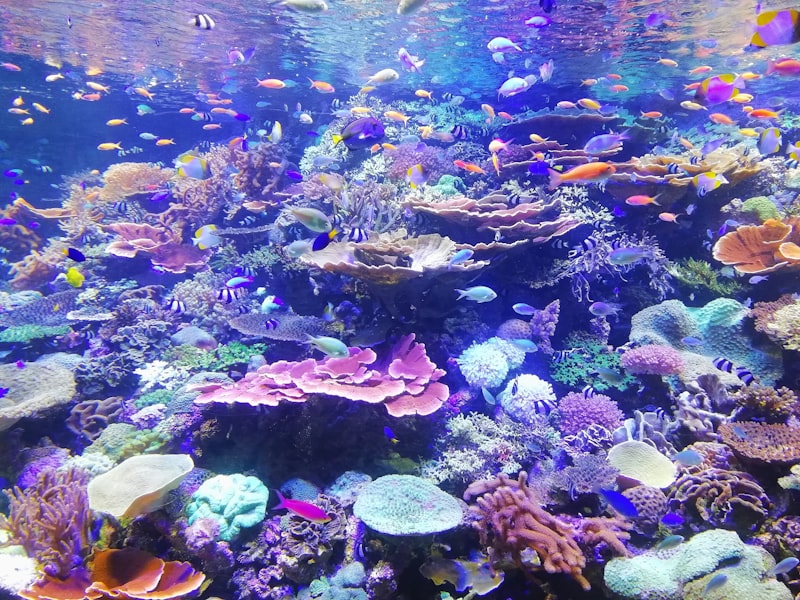Ever wondered about the bizarre inhabitants of our oceans? Dive into the fascinating world of strange and rare fish species that roam the depths of our planet’s waters. These extraordinary creatures defy imagination and showcase nature’s creativity in full display.
Imagine encountering the otherworldly Blobfish, often described as a gelatinous mass with a face only a mother could love. Found off the coast of Australia, it inhabits deep waters where the pressure is extreme, making its squishy appearance an adaptation to its environment.
Venture into the Amazon Rainforest and you might stumble upon the fearsome Vampire Tetra, a fish with dagger-like teeth that resemble those of a vampire. Its predatory prowess and razor-sharp teeth make it a formidable hunter in its habitat.

In the frigid waters of the Antarctic, the Icefish challenges the norms with its transparent appearance and lack of red blood cells. This adaptation allows it to survive in temperatures that would freeze most other fish solid.
The psychedelic Mandarin Fish, found in the Pacific Ocean, is a sight to behold with its vibrant colors and intricate patterns. It’s no wonder it’s a favorite among divers and photographers seeking to capture its stunning beauty.
Heading to the deep sea, the Anglerfish lurks with its bioluminescent lure dangling above its toothy mouth. This clever adaptation attracts unsuspecting prey in the darkness, making it a true master of camouflage and deception.
These extraordinary fish species not only highlight the diversity of life in our oceans but also remind us of the mysteries waiting to be uncovered beneath the waves. Each one is a testament to the wonders of evolution and adaptation, showcasing nature’s endless capacity to surprise and inspire.
Deep Sea Wonders: Unveiling the World’s Most Bizarre Fish Species
Imagine diving into the depths of the ocean, where darkness reigns and mystery thrives. Here, amidst the silent expanse, lies a realm of creatures so bizarre and fantastical that they defy imagination. These are the deep sea wonders—the most peculiar fish species that inhabit the abyssal plains and trenches of our planet.
One such marvel is the Anglerfish, a master of disguise and deception. With its bioluminescent lure dangling above its gaping jaws, this fish attracts unsuspecting prey like moths to a flame. It’s a true testament to nature’s ingenuity, blending both beauty and terror in its design.
Then there’s the Blobfish, often dubbed the “ugliest fish in the world.” Residing in the deep waters off Australia and New Zealand, this gelatinous creature has a face only a mother could love. Its unique appearance is a result of the extreme pressure at such depths, where its body becomes a gel-like mass—a perfect adaptation to its harsh environment.
Moving deeper into the abyss, we encounter the Fangtooth Fish, aptly named for its long, dagger-like teeth. Despite its menacing appearance, this fish is relatively small, measuring only a few inches in length. Yet, in the realm of the deep, size matters little compared to survival skills honed over millennia of evolution.
The Gulper Eel is another oddity, known for its large mouth that can engulf prey much larger than itself. This eel has adapted to its dark surroundings with a bioluminescent lure at the end of its tail, allowing it to attract food in the pitch-black depths where it resides.
Lastly, the Vampire Squid deserves mention for its otherworldly appearance and behavior. Unlike its namesake, this creature is harmless to humans but possesses retractable filaments that give it a cloak-like appearance—a strategy to ward off potential threats in its deep-sea home.
These bizarre fish species are a testament to the sheer diversity of life on Earth, especially in the unexplored depths of our oceans. They remind us that even in the darkest corners of our planet, nature continues to surprise and inspire with its ingenuity and adaptation.
Meet the ‘Aliens’ of the Ocean: Rare Fish That Defy Imagination
Have you ever wondered about the creatures lurking beneath the ocean’s surface? Beyond the familiar fish and coral reefs lies a realm where reality often seems stranger than fiction. Enter the world of deep-sea exploration, where scientists encounter species that seem straight out of science fiction—aquatic aliens that defy imagination.
One such marvel is the barreleye fish, sporting a transparent head that reveals its internal organs. Imagine swimming alongside a creature with eyes that gaze directly upward, through its own skull! These adaptations help it navigate the deep, where light is scarce and survival demands ingenious solutions.
Then there’s the anglerfish, infamous for its bioluminescent lure dangling from its forehead like a fishing pole. It’s a scene right out of a dark fairy tale—a predator using light to attract unsuspecting prey into its waiting jaws. Nature’s own angler, hunting in the perpetual darkness of the ocean depths.
Moving into shallower waters, we encounter the psychedelic frogfish. With its vibrant colors and bizarre appendages resembling seaweed, it blends seamlessly into its surroundings, ready to ambush passing fish with lightning speed. It’s a master of disguise, showcasing evolution’s creativity in adapting to its environment.
Not to be outdone, the sarcastic fringehead claims its territory with an aggressive display of its oversized mouth, ready to defend its home against any intruder—no matter the size. This tiny yet fierce warrior is a testament to the diverse strategies creatures employ to survive in the harsh underwater world.
As we delve deeper into the ocean’s mysteries, each new discovery challenges our understanding of life itself. From the depths where sunlight fades to the creatures that thrive in extreme conditions, these ‘aliens’ of the ocean remind us of the boundless wonders yet to be explored. What other secrets lie hidden beneath the waves, waiting for intrepid explorers to uncover?
Beyond the Reef: Exploring the Hidden Gems of Rare Fish Diversity
Diving into the depths of our oceans unveils a world of breathtaking diversity, where each ripple hides a story waiting to be told. Among these aquatic marvels, rare fish species shimmer like jewels in the sunlit waters, their vibrant colors and unique adaptations captivating marine enthusiasts and scientists alike.
Imagine encountering the elusive Coelacanth, often dubbed a “living fossil,” whose ancient lineage dates back millions of years. This prehistoric fish, with its lobed fins and sturdy scales, embodies resilience against the currents of time, offering a glimpse into the evolutionary tapestry of our planet’s oceans.
Venture deeper, and the psychedelic patterns of the Mandarin fish mesmerize observers with their kaleidoscopic hues. These diminutive creatures, known for their intricate courtship dances during twilight hours, epitomize nature’s artistry in the hidden corners of coral reefs.
In the azure waters of the Pacific, the Ribbon Eel undulates gracefully, its sinuous form resembling a flowing ribbon in the underwater currents. With its striking blue coloration that changes as it matures, this eel stands out as a testament to the diversity of shapes and colors that adorn our oceans’ floors.
Meanwhile, the Ghost Pipefish, a master of disguise, showcases nature’s ingenuity with its leaf-like appendages that camouflage it amidst seagrass beds and coral outcrops. Its ability to blend seamlessly into its surroundings underscores the importance of adaptation in the survival of these fragile ecosystems.
Exploring these hidden gems of rare fish diversity not only inspires wonder but also underscores the urgency of conservation efforts. Each species, with its unique characteristics and ecological role, contributes to the delicate balance of marine life. Preserving their habitats and understanding their behaviors is crucial for safeguarding biodiversity in our oceans for generations to come.
As we continue to unravel the mysteries of these underwater marvels, let us marvel at their beauty and resilience, reminding ourselves of the interconnectedness of all life on Earth. Each encounter with these rare fish species is a chance to deepen our appreciation for the wonders that lie beyond the reef.
From Deep Trenches to Tropical Shores: Rare Fish That Astound Scientists

One of the most astonishing finds in recent years is the anglerfish, a deep-sea dweller that embodies nature’s ingenuity in survival. With its bioluminescent lure dangling from its head like a fishing rod, this fish attracts prey in the pitch-black depths where sunlight cannot penetrate. Scientists marvel at its ability to thrive in such extreme conditions, where food is scarce and survival is a constant battle.
Moving closer to the surface, the vibrant world of tropical shores unveils another marvel: the mandarinfish. Found in the warm waters of the Indo-Pacific, this small, brightly colored fish captivates with its kaleidoscopic patterns and delicate movements. Its striking appearance serves a dual purpose of camouflage and warning, showcasing nature’s artistry in evolution.
Further along the spectrum of rarity is the coelacanth, a prehistoric fish once thought to have been extinct for millions of years until its rediscovery in the 20th century. Dubbed a “living fossil,” this deep-sea giant challenges scientific understanding with its primitive features that harken back to a bygone era. Its existence underscores the mysteries of evolution and adaptation over millennia.
In the shallower waters of coral reefs, the seahorse stands out not only for its unique appearance but also for its extraordinary reproductive habits. Unlike most fish, it is the male seahorse that carries and gives birth to the offspring, a role reversal that continues to intrigue scientists studying reproductive biology and parental care in marine organisms.
Each of these rare fish species, whether dwelling in the deep trenches or shimmering among tropical shores, offers a testament to the resilience and diversity of life in our oceans. As scientists uncover more about their behaviors, adaptations, and ecological roles, the allure of these aquatic wonders only deepens, reminding us of the endless surprises that the natural world has yet to reveal.
Frequently Asked Questions
Why is conservation important for protecting rare fish species globally?
Conservation efforts are crucial for protecting rare fish species globally because they help maintain biodiversity, prevent extinction, and preserve fragile ecosystems. By safeguarding these species, we ensure the balance of aquatic environments and sustain the benefits they provide to human populations.
Where can I find rare fish species in different parts of the world?
Discover where rare fish species can be found across the globe with our concise guide. Explore diverse habitats from the Amazon rainforest to the coral reefs of Australia. Learn about specific locations renowned for unique aquatic life, offering insights for enthusiasts and researchers alike.
What are some examples of strange fish species found around the world?
Explore a variety of unusual fish species discovered globally, showcasing remarkable adaptations and appearances. Discover creatures like the Blobfish, the Anglerfish with its glowing lure, and the bizarre-looking Goblin Shark.
How do strange fish adapt to their unique environments?
Learn how strange fish adapt to their unique environments by developing specialized physical features, behaviors, and metabolic processes that enable survival in extreme conditions.
What are the characteristics that make fish species rare or unusual?
Discover why certain fish species are considered rare or unusual based on specific characteristics such as habitat specificity, limited geographic range, specialized feeding behaviors, unique physiological adaptations, and low population numbers.


